On Still Life Painting and Longing for Beauty
By Adam Clague

While hiking in Hocking Hills, Ohio, my wife and I encountered several spectacular waterfalls. At each one, I was uniquely and intensely inspired. But on one occasion, I was especially aware of my response to the falls’ beauty. I was mesmerized, compelled to simply stare in quiet, reflective awe at the majesty before me. After awhile, I looked around at the other hikers that had stopped there. I don’t know if any of them was feeling exactly as I was, but their halted feet and riveted eyes were evidence that they too had recognized the beauty of the scene.
Once beauty is encountered and realized, I think a very natural response follows—the desire to capture, preserve and share it. This urge is not just felt by artists. Some of the other hikers pulled out their cameras as I did, and though I’m sure we all knew our cameras couldn’t fully capture the moment, we were compelled to at least try.
No device or medium can fully capture this world’s visual beauty, but representational painting can come stunningly close. When commanded by a skilled artist, representational painting has the potential to relate a subject’s appearance faithfully to the way it is perceived by the human eye. To effectively translate real-life beauty through paint, the artist must first learn to objectively observe and analyze his subject’s appearance. As he trains his eyes, the artist not only becomes better able to relate beauty, but also becomes keenly aware that beauty is everywhere. It is present not only in subjects widely considered beautiful, but also in the mundane. Beauty is even found in things one might hastily label “ugly.”
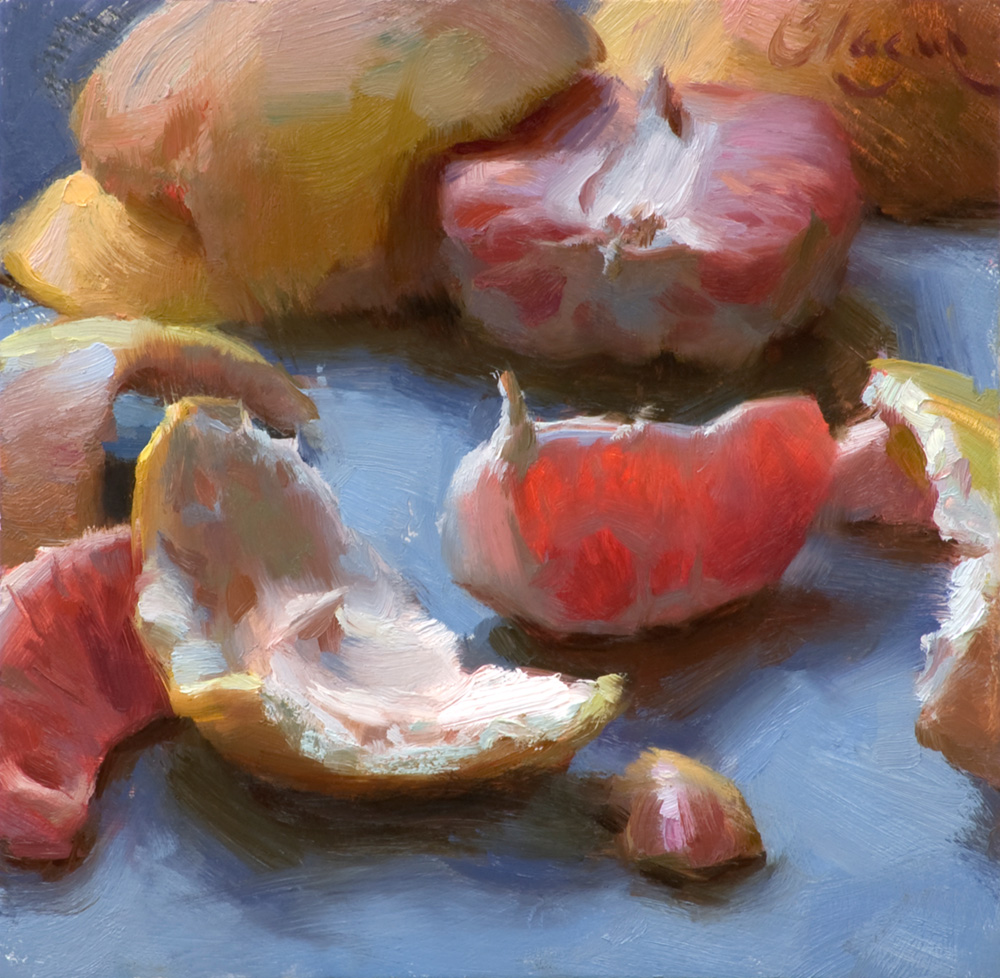
I began to better understand how beauty can be found everywhere after reading Daniel Gerhartz’s article in Artists On Art*. In it, Gerhartz shares how he analyzes the paintings that have especially moved him, in order to determine why they affect him so. He concluded that his initial attraction to a painting is not due to its subject matter, color or composition, but rather to its “convincing effect of light.”
I thought of some of the paintings I had seen whose beauty had gripped me. Often, after admiring such a painting for a while, I have suddenly realized that its subject is one whose beauty I never would have otherwise seen. In such cases, it is light’s effect on the subject that has captured me more than the subject’s own form. To be sure, some subjects are more intrinsically beautiful than others. But I have come to learn that light itself is beautiful and seems to impart beauty to all it bathes, even to subjects that most might consider unsightly.
Light is the means by which our world is revealed to our eyes. Though there may be slight variations in the way each pair of eyes sees, the science of light remains universal. Therefore, if an artist wishes his work to be universally understood on a visual level, he must learn to observe, analyze and translate the effects of light honestly and truthfully. Within this framework of truth is abundant opportunity for the artist to communicate his own response to the beauty he beholds. I marvel how nature’s beauty—as well as the artist’s response to it—can be preserved and shared, so that others can enjoy beauty they might never have otherwise noticed.
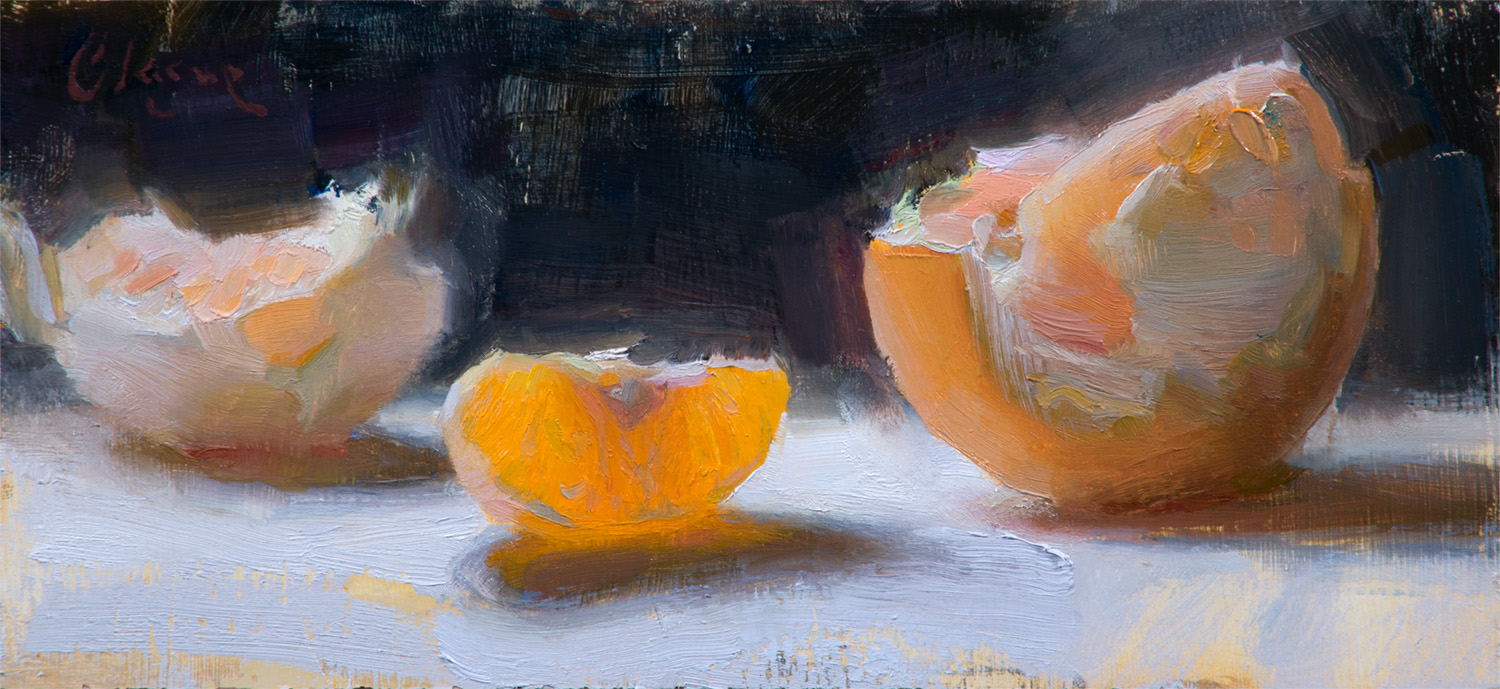
Still Life Painting, Below the Surface
Until now, I’ve only talked about beauty on a surface level. However, it is interesting that we apply the word “beautiful” to both the visible and the invisible. To be sure, nature is beautiful, but so is kindness, justice and love. In contrast, one might use the word “ugly” to describe an act of hate. Fascinatingly, although painting is a visual medium, it has the power to depict both visible and invisible beauty (or ugliness). With this power comes the responsibility of the artist to uphold beauty.
In saying earlier that any subject can be made beautiful by light, I did not mean to imply that I believe an artist should paint every subject under the sun. Nature’s light can reveal beauty in a subject’s outer form, but cannot redeem any inner ugliness. I believe that if an artist depicts an inwardly ugly subject, he should do so in a way that does not condone or promote the ugliness, but rather in a way that inspires his audience to embrace beauty.

I believe each of us has a longing for beauty, for things to be as they should. One might stifle these feelings or give up hope of ever finding beauty in his life, but the ache remains. Representational art appeals to this longing by testifying that, in the midst of an ugly world, beauty still exists—both within the artwork and in the subject depicted—while pointing to an even higher beauty.
In The Weight of Glory, C.S. Lewis wrote, “The books or the music in which we thought the beauty was located will betray us if we trust to them; it was not in them, it only came through them, and what came through them was longing. These things—the beauty, the memory of our own past—are good images of what we really desire; but if they are mistaken for the thing itself they turn into dumb idols, breaking the hearts of their worshippers. For they are not the thing itself; they are only the scent of a flower we have not found, the echo of a tune we have not heard, news from a country we have never yet visited.”
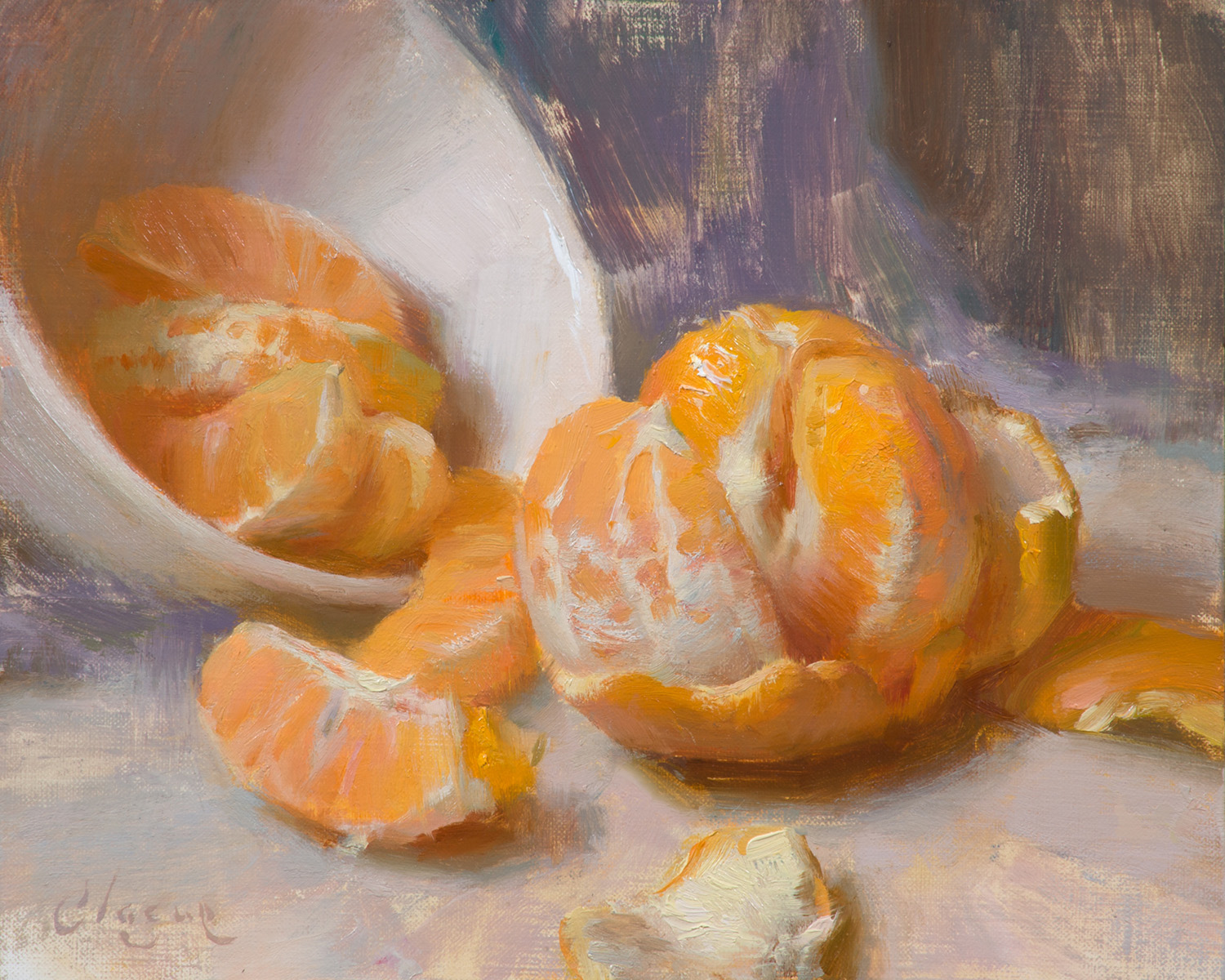
Representational painting provides vast potential for people to share and receive glimpses of the beauty that is still present within a troubled world. Though I wish for people to find enjoyment in my work, I also hope they will look past my subjects, beyond my paintings, to the beauty that actually exists in nature. The world around us is a far greater work of Art than I could ever hope to reflect. And just as a great painting testifies to a skilled artist, nature’s glory proclaims a beautiful Creator. It is from Him that all beauty originates, and by Him that all will be made right. As nature’s light brings outward beauty to all it touches, His true Light redeems the inner ugliness of all that receive it. It is in these truths that my hope and longing for beauty is finally satisfied.
Nature’s infinite display of beauty, found in everything, from the grandest waterfall to the simplest branch, holds me in continual awe. I count it a privilege to pursue the gift of art and am thankful for the opportunity it brings to share the wonders of Creation with others.
***
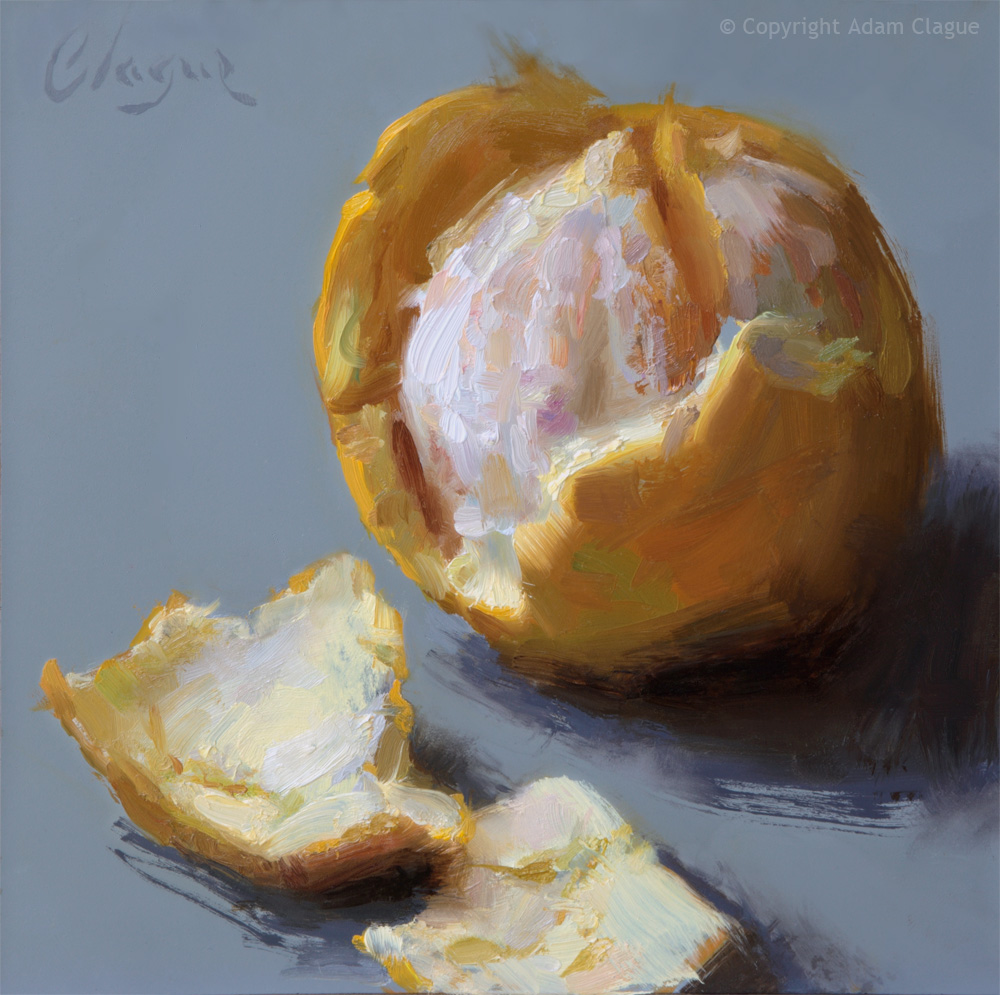
When I held an orange under cool window light, a beautiful harmony of colors was revealed that I just had to capture. I called the resulting painting “Only an Orange” (above) because although the subject was ordinary, its beauty was spectacular! I’m continually amazed how great beauty can be found in all parts of Creation, even the most mundane. We just have to keep our eyes open for it.
***
Step by Step Painting Demo: A Truly White Christmas
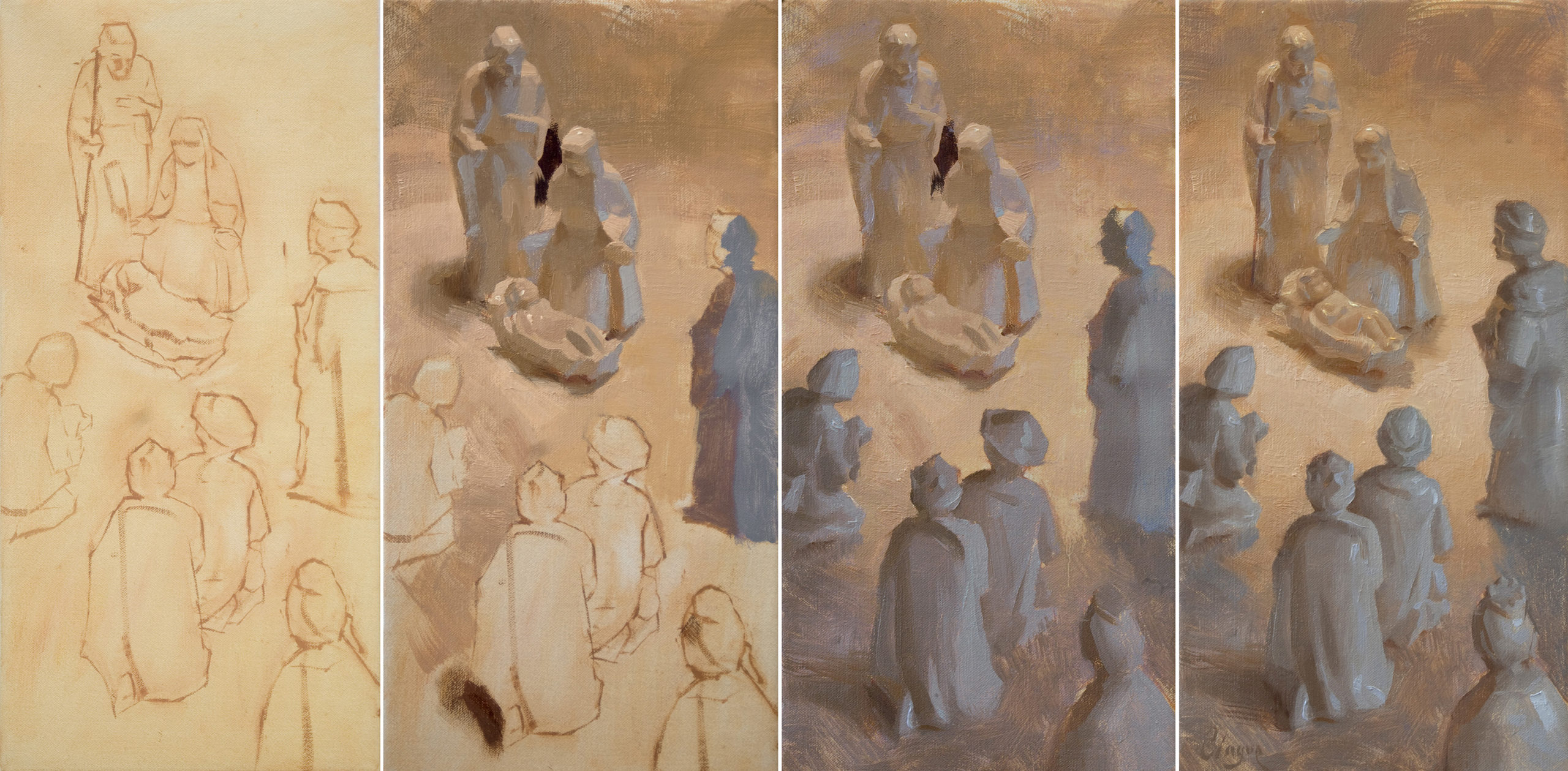
1. TONE AND DRAWING
All of my paintings are built upon a foundation of drawing. Sometimes the drawing is very simple; other times it is more complex. For this painting, I took my time to make a fairly complete initial drawing to ensure accuracy in the figurines and provide anchoring for my design.
2. BLOCK-IN
After establishing my drawing, I began to lay down shapes of color. At this point, the shapes had sharp, “blocky” outer edges because I was primarily focussed on achieving correct values and temperatures. Because the scene consisted of only light and middle-range tones, I had trouble gauging some of my values until I temporarily placed a black object behind Joseph and Mary for comparison.
3. FURTHER BLOCK-IN
At this stage, the entire canvas was blocked-in with minimal softening between shapes.
4. FINAL
Once I felt the values and temperatures were relating to each other accurately, I proceeded to soften edges and further refine my painting until it was finished.
To see more of Adam’s work and learn about his instructional offerings, please visit ClagueFineArt.com.
*Artists on Art magazine became RealismToday.com in 2019
Visit EricRhoads.com (Publisher of Realism Today) to learn about opportunities for artists and art collectors, including: Art Retreats – International Art Trips – Art Conventions – Still Life Painting Art Workshops (in person and online, including Realism Live) – And More!


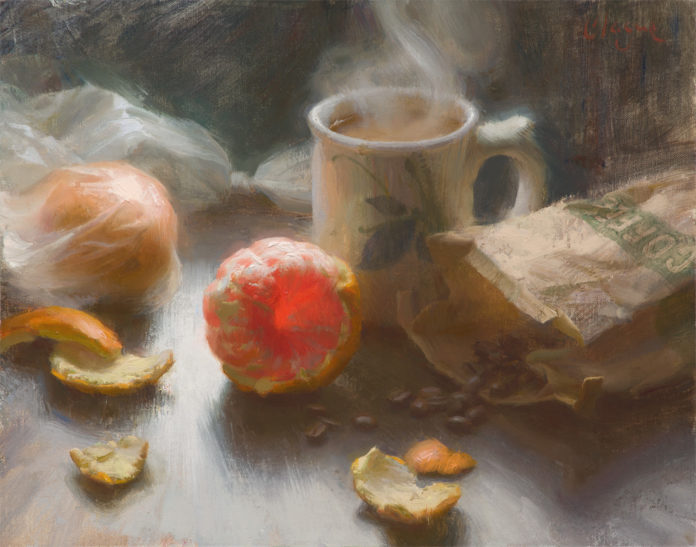



Beautiful work, Adam. Love the luminosity and the gorgeous colors in these studies.
What a beautiful way you have found to share your faith Adam, the strength of your work is empowered by your love of our Father. I’ll never look at your citrus in the same way again.
Comments are closed.